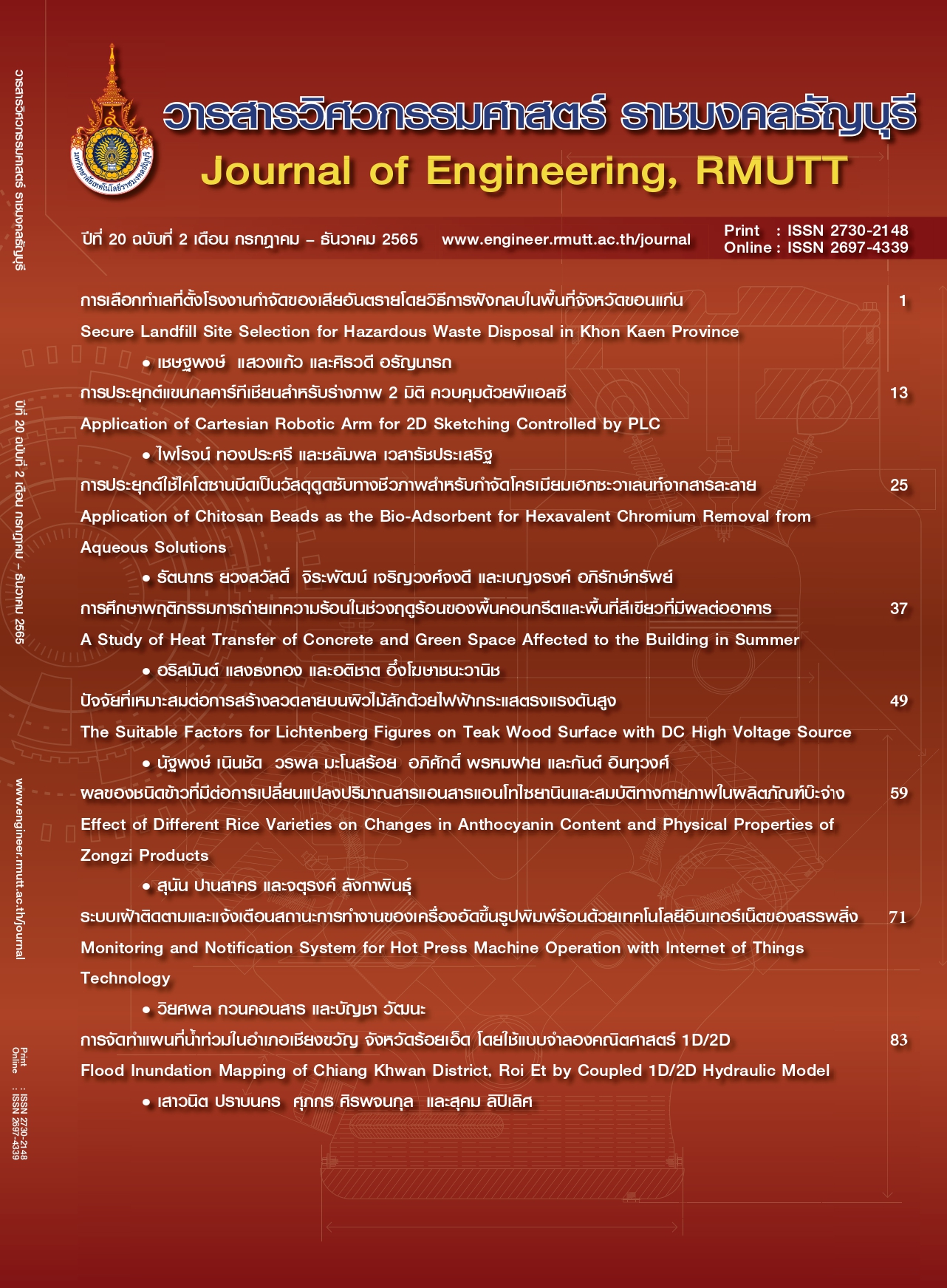การประยุกต์ใช้ไคโตซานบีดเป็นวัสดุดูดซับทางชีวภาพ สำหรับกำจัดโครเมียมเฮกซะวาเลนท์จากสารละลาย
Main Article Content
บทคัดย่อ
งานวิจัยนี้ศึกษาประสิทธิภาพการดูดซับโครเมียมเฮกซะวาเลนท์จากน้ำเสียสังเคราะห์ โดยใช้ไคโตซานเชื่อมขวางด้วยโซเดียมไตรพอลิฟอสเฟตและขึ้นรูปเป็นเม็ดบีดเป็นวัสดุดูดซับ ทดสอบความสามารถในการดูดซับโดยใช้การทดลองแบบกะ ศึกษาตัวแปรที่มีผลต่อการดูดซับ ได้แก่ pH ของสารละลาย ความเข้มข้นเริ่มต้นของสารละลายโครเมียม อุณหภูมิในการดูดซับ และปริมาณวัสดุดูดซับ จากผลการทดสอบพบว่าร้อยละการดูดซับโครเมียมเพิ่มขึ้นอย่างรวดเร็วใน 20 นาทีแรก และการดูดซับเข้าสู่สมดุลภายในเวลา 90 นาที pH ของสารละลายโครเมียมมีผลต่อประสิทธิภาพการดูดซับอย่างชัดเจน โดยการดูดซับเกิดขึ้นได้ดีในภาวะที่เป็นกรด ภาวะที่เหมาะสมในการดูดซับ คือ pH เท่ากับ 2 ความเข้มข้นเริ่มต้นของสารละลายโครเมียม เท่ากับ 2 mg/L ปริมาณบีดไคโตซานเท่ากับ 2 g ได้ร้อยละการดูดซับโครเมียมเท่ากับ 92 ซึ่งมีค่าสูงกว่าการใช้ไคโตซานแบบผงเป็นวัสดุดูดซับที่มีค่าร้อยละการดูดซับเท่ากับ 86 จากการศึกษาไอโซเทอมการดูดซับพบว่าการดูดซับสอดคล้องกับแบบจำลองของแลงเมียร์และจลนพลศาสตร์การดูดซับเป็นแบบอันดับสองเทียม แสดงให้เห็นว่าการดูดซับโครเมียมเฮกซะวาเลนท์บนบีดไคโตซานเป็นการดูดซับทางเคมีและเกิดขึ้นแบบชั้นเดียว จากผลการศึกษาแสดงให้เห็นว่าบีดไคโตซานเป็นวัสดุดูดซับที่มีประสิทธิภาพในการกำจัดโครเมียมเฮกซะวาเลนท์และแยกออกจากสารละลายได้ง่าย
Article Details

อนุญาตภายใต้เงื่อนไข Creative Commons Attribution-NonCommercial-NoDerivatives 4.0 International License.
บทความ ข้อมูล เนื้อหา รูปภาพ ฯลฯ ที่ได้รับการตีพิมพ์ในวารสารแนวหน้าวิจัยนวัตกรรมทางวิศวกรรม ถือเป็นลิขสิทธิ์ของวารสารฯ เท่านั้น ไม่อนุญาติให้บุคคลหรือหน่วยงานใดคัดลอกเนื้อหาทั้งหมดหรือส่วนหนึ่งส่วนใดไปเผยแพร่เพื่อกระทำการใด ๆ ที่ไม่ถูกต้องตามหลักจริยธรรม
เอกสารอ้างอิง
Munter R. Industrial wastewater characteristics. Academia. [Internet]. 2003 [cited 2022 Sep 1];185-194. Available from: https://shorturl.asia/lRHd1
Akpor OB, Ohiobor GO, Olaolu TD. Heavy metal pollutants in wastewater effluent: Sources, effects and remediation. Advances in bioscience and bioengineering. 2014;2(4):37-43.
Peng H, Guo J. Removal of chromium from wastewater by membrane filtration, chemical precipitation, ion exchange, adsorption electro coagulation, electrochemical reduction, elec -trodialysis, electrodeionization, photocatalysis and nanotechnology: A review. Environmental chemistry letters. 2020;18:2055-68.
Mnif A, Bejaoui I, Mouelhi M, Hamrouni B. Hexavalent chromium removal from model water and car shock absorber factory effluent by nanofiltration and reverse osmosis membrane. International journal of analytical chemistry. 2017;1-10.
Jung C, Heo J, Han J, Her N, Lee SJ, Oh, J Ryu J. Hexavalent chromium removal by various adsorbents: powdered activated carbon, chitosan, and single/multi-walled carbon nanotubes. Separation and purification technology. 2013;106:63-71.
Meez E, Rahdar A, Kyzas GZ. Sawdust for the removal of heavy metals from water: A review. Molecules. 2021;26(4318):1-21.
Ajouyed O, Hurel C, Marmier N. Evaluation of the adsorption of hexavalent chromium on kaolinite and illite. Journal of environmental protection. 2011;2:1347-52.
Mehr MR, Fekri MH, Omidali F, Eftekhari N, Akbari-adergani B. Removal of Chromium (VI) from wastewater by palm kernel shell-based on a green method. Journal of chemical health risks. 2019;9(1):75-86.
Piyamongkala K, Sripakdee W. Kinetic and thermodynamic of chromium (VI) adsorption from electroplating wastewater by crosslinked chitosan resin. Research and development journal. 2009;20(3):87-98. (in Thai)
Hua C, Zhang R, Bai F, Lu P, Liang X. Removal of chromium (VI) from aqueous solutions using quaternized chitosan microspheres. Chinese journal of chemical engineering. 2017;25:153-8.
Siraj S, Islam MDM, Das PC, Masum SMD, Jahan IA, Shajahan MD. Removal of chromium from tannery effluent using chitosan-chacoal composite. Journal of Bangladesh chemical society, 2012; 25(1):53-61.
Nomanbhay SM, Palanisamy K. Removal of heavy metal from industrial wastewater using chitosan coated oil palm, shell charcoal. Electronic Journal of Biotechnology. 2005;8(1):43-53.
Yuangsawad R, Piyo S, Kasetniyom N. Chromium (VI) removal using crosslinked chitosan in fixed bed column. Journal of science and technology RMUTSB. 2021;5(1):11-22. (in Thai)
Bhumkar DR, Pokharkar VB. Studies on effect of pH on cross-linking of chitosan with sodium tripolyphosphate: A technical note. AAPS PharmSciTech. 2006;7(2):E1-6.
Gorzin F, Abadi BR. Adsorption of Cr(VI) from aqueous solution by adsorbent prepared from paper mill sludge: Kinetics and thermodynamics studies. Adsorption science & technology. 2018;36 (1-2):149-169.
Aydin YA, Aksoy ND. Adsorption of chromium on chitosan: Optimization, kinetics and thermodynamics. Chemical engineering journal. 2009;151:188-94.


